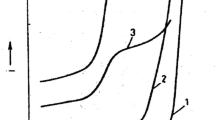Abstract
The impedance of the junction between a solid or aqueous electrolyte and a metal electrode at which no charge transfer processes occur (blocking contacts) follows closely the constant phase angle form, Z=A(jω)-n, over a wide frequency range, where A is a constant, and the frequency exponent n is typically in the range of 0.7 to 0.95. Several models have been proposed in which the magnitude of the frequency exponent n is related by a simple expression to the fractal dimension\(\bar d\) of the rough electrode surface. But experiments with aqueous H2SO4 and roughened platinum and silicon electrodes show that there is no simple relationship, if any at all, between n and\(\bar d\) when\(\bar d\) is determined from the analysis of one dimensional surface profiles. Moreover, n is not a simple function of the average roughness of the electrode. In order to gain some insight into the effect of electrode topography and the interface impedance, a model for the response of the interface to a constant voltage pulse was constructed. This model is based on the idea that, following a pulse, locally concentrated regions of ions accumulate rapidly at the tips of large protrusions on the electrode surface which screens deeper regions of the electrode from the field driven flux of mobile ions. After this rapid charging, ions are able to reach the deeper, screened regions of the electrode by diffusion, and it is this diffusive process that gives rise to the observed t1−n dependence of the charge collected. Computer simulations, similar to the diffusion limited aggregation model, using measured profiles as fixed (non-growing) clusters, gave exponents n in good agreement with experiment.
Similar content being viewed by others
References
Bates, J.B.; Chu, Y.T.; Stribling, W.T. Surface topography and impedance of metal-electrolyte interfaces. Phys. Rev. Lett. 60:627–630; 1988.
Bates, J.B.; Wang, J.C. Dielectric response of ionic conductors. Solid State Ionics 28–30; 115–119; 1988.
Bates, J.B.; Wang, J.C.; Chu, Y.C. Interface and bulk relaxation in solid ionic conductors. J. Non-Cryst. Solids 131–133:1046–1052; 1991.
Bates, J.B.; Wang, J.C.; Chu, Y.T. Impedance of metal-solid electrolyte interfaces. Solid State Ionics 18–19:1045–1049; 1986.
Berry, M.V. Diffractals. J. Phys. A: Math. Gen. 12:781–797; 1979.
Blender, R.; Dieterich, W.; Kirchkoff, T.; Sapoval, B. Impedance of fractal interfaces. J. Phys. A. 23:1225–1231; 1990.
Bottleberghs, P.H.; Broers, G.H.J. Interfacial impedance behaviour of polished and paint platinum electrodes at Na2WO4-Na2MoO4 solid electrolytes. J. Electroanal. Chem. 67:155–167; 1976.
Breiter, M. W. Impedance on platium from voltammetry with superimposed alternating voltage. Electroanal. Chem. 7:38–49; 1964.
de Levie, R. The influence of surface roughness of solid electrodes on electrochemical measurements. Electrochemica Acta 10:113–130; 1965.
Kaplan, T.; Gray, L.J. Effect of disorder on a fractal model for the ac response of a rough interface. Phys. Rev. B. 32:7360–7366; 1985.
Kaplan, T.; Gray, L.J.; Liu, S.H. Self-affine fractal model for a metal-electrolyte interface. Phys. Rev. B. 35:5379–5381; 1987.
Keddam, M.; Takenouti, H. Frequence dependence of complex transfer function at fractal interfaces. An approach based on the Von Koch model. C. R. Acad. Sc. Paris 302:281–284; 1986.
Le Mehaute, A.; Grepy, G. Introduction to transfer and motion in fractal media: The geometry of kinetics. Solid State Ionics 9–10:17–30; 1983.
Liu, S.H. Fractal model for the ac response of a rough interface. Phys. Rev. Lett. 55:529–532; 1985.
Mandelbrot, B.B. Self-affine fractals and fractal dimension. Phys. Scr. 32:257–260; 1985.
Matsushita, M.; Sano, M.; Hayakawa, Y.; Honjo, H.; Sawada, Y. Fractal structures of zine metal leaves grown by electrodeposition. Phys. Rev. Lett. 53:286–289; 1964.
Nyikos, L.; Pajkossy, T. Fractal dimension and fractional power frequency-dependent impedance of blocking electrodes. Electrochemica Acta 30:1533–1540; 1985.
Pajkossy, T.; Nyikos, L. Impedance of fractal blocking electrodes. J. Electrochem. Soc. 133:2061–2064; 1986.
Sapoval, B. Fractal electrodes and constant phase angle response: Exact examples and counter examples. Solid State Ionics 23:253–259; 1987.
Sapoval, B.; Chazairel, J.-N.; Peyrière, J. Electrical response of fractal and porous interfaces. Phys. Rev. A. 38:5876–5887; 1988.
Sayles, R.S.; Thomas, T.R. The spatial representation of surface roughness by means of the structure function: A practical alternative to correlation. Wear 42:263–276; 1977.
Scheider, W. Theory of the frequency dispersion of electrode polarization. Topology of networks with fractional power frequency dependence. J. Phys. Chem. 79:127–136; 1975.
Tamimura, Y.; Teague, E.C.; Scire, F.E.; Yung, R.D.; Vorburger, T.V. Graphical signatures for manufactured surfaces. J. Lubr. Technol. 105:533–537; 1982.
Voss, R.F. Random fractal forgeries. In: Earnshaw, R.A., ed. Fundamental algorithms in computer graphics. Nato Advanced Study Institute, Series F., Vol. 17, Berlin: Springer-Verlag; 1985: pp. 805–828.
Wang, J.C. Realizations of generalized Warburg impedance with RC ladder networks and transmission lines. J. Electrochem. Soc. 134:1915–1920; 1987.
Wang, J.C. Impedance of a fractal electrolyte-electrode interface. Electrochem. Acta 33:707–711; 1988.
Wang, J.C. Comparison of fractal and pore models for electrolyte/electrode interfaces. Solid State Ionics 28–30:1436–1440; 1988.
Wang, J.C.; Bates, J.B. Model for the interfacial impedance between a solid electrolyte and a blocking metal electrode. Solid State Ionics 18–19:224–228; 1986.
Whitten, T.A., Jr.; Sander, L.M. Diffusion-limited aggregation, a kinetic critical phenomenon. Phys. Rev. Lett. 47:1400–1403; 1981.
Wolff, I. A study of polarization capacity over a wide frequency band. Phys. Rev. 27:755–763; 1926.
Author information
Authors and Affiliations
Rights and permissions
About this article
Cite this article
Bates, J.B., Chu, Y.T. Electrode-electrolyte interface impedance: Experiments and model. Ann Biomed Eng 20, 349–362 (1992). https://doi.org/10.1007/BF02368536
Received:
Revised:
Issue Date:
DOI: https://doi.org/10.1007/BF02368536




